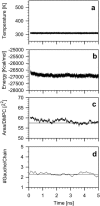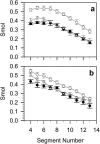Effects of epicholesterol on the phosphatidylcholine bilayer: a molecular simulation study
- PMID: 12609883
- PMCID: PMC1302750
- DOI: 10.1016/S0006-3495(03)74989-3
Effects of epicholesterol on the phosphatidylcholine bilayer: a molecular simulation study
Abstract
Epicholesterol (Echol) is an epimeric form of cholesterol (Chol). A molecular dynamics simulation of the fully hydrated dimyristoylphosphatidylcholine-Echol (DMPC-Echol) bilayer membrane containing approximately 22 mol % of Echol was carried out for 5 ns. A 3-ns trajectory generated between 2 and 5 ns of molecular dynamics simulation was used for analyses to determine the effects of Echol on the membrane properties. As reference systems, pure DMPC and mixed DMPC-Chol bilayers were used. The study shows that Echol, like Chol, changes the organization of the bilayer/water interface and increases membrane order and condensation, but to a lesser degree. Effects of both sterols are based on the same atomic level mechanisms; their different strength arises from different vertical localizations of Echol and Chol hydroxyl groups in the membrane/water interface.
Figures









Similar articles
-
Cholesterol effects on a mixed-chain phosphatidylcholine bilayer: a molecular dynamics simulation study.Biochimie. 2006 May;88(5):449-60. doi: 10.1016/j.biochi.2005.10.005. Epub 2005 Nov 7. Biochimie. 2006. PMID: 16356621
-
Cholesterol effects on the phosphatidylcholine bilayer polar region: a molecular simulation study.Biophys J. 2000 Mar;78(3):1376-89. doi: 10.1016/S0006-3495(00)76691-4. Biophys J. 2000. PMID: 10692323 Free PMC article.
-
Cholesterol effects on the phospholipid condensation and packing in the bilayer: a molecular simulation study.FEBS Lett. 2001 Jul 27;502(1-2):68-71. doi: 10.1016/s0014-5793(01)02668-0. FEBS Lett. 2001. PMID: 11478950
-
Molecular dynamics simulation studies of lipid bilayer systems.Acta Biochim Pol. 2000;47(3):601-11. Acta Biochim Pol. 2000. PMID: 11310963 Review.
-
Computational study of DMPC liposomes loaded with the N-(2-Hydroxyphenyl)-2-propylpentanamide (HO-AAVPA) and determination of its antiproliferative activity in vitro in NIH-3T3 cells.J Biomol Struct Dyn. 2022;40(21):11448-11459. doi: 10.1080/07391102.2021.1955744. Epub 2021 Jul 27. J Biomol Struct Dyn. 2022. PMID: 34315332 Review.
Cited by
-
Large conductance, calcium- and voltage-gated potassium (BK) channels: regulation by cholesterol.Pharmacol Ther. 2012 Aug;135(2):133-50. doi: 10.1016/j.pharmthera.2012.05.002. Epub 2012 May 11. Pharmacol Ther. 2012. PMID: 22584144 Free PMC article. Review.
-
Cholesterol-sphingomyelin interactions: a molecular dynamics simulation study.Biophys J. 2006 Nov 15;91(10):3756-67. doi: 10.1529/biophysj.106.080887. Epub 2006 Aug 18. Biophys J. 2006. PMID: 16920840 Free PMC article.
-
Effects of a carane derivative local anesthetic on a phospholipid bilayer studied by molecular dynamics simulation.Biophys J. 2003 Aug;85(2):1248-58. doi: 10.1016/S0006-3495(03)74560-3. Biophys J. 2003. PMID: 12885668 Free PMC article.
-
Specificity of cholesterol and analogs to modulate BK channels points to direct sterol-channel protein interactions.J Gen Physiol. 2011 Jan;137(1):93-110. doi: 10.1085/jgp.201010519. Epub 2010 Dec 13. J Gen Physiol. 2011. PMID: 21149543 Free PMC article.
-
Stereospecific Interactions of Cholesterol in a Model Cell Membrane: Implications for the Membrane Dipole Potential.J Membr Biol. 2018 Jun;251(3):507-519. doi: 10.1007/s00232-018-0016-0. Epub 2018 Jan 30. J Membr Biol. 2018. PMID: 29383401
References
-
- Berendsen, H. J. C., J. P. M. Postma, W. F. van Gunsteren, A. DiNola, and J. R. Haak. 1984. Molecular dynamics with coupling to an external bath. J. Chem. Phys. 81:3684–3690.
-
- Brainard, J. R., and E. H. Cordes. 1981. Carbon-13 nuclear magnetic resonance studies of cholesterol-egg yolk phosphatidylcholine vesicles. Biochemistry. 20:4607–4617. - PubMed
-
- Brzozowska, I., and Z. A. Figaszewski. 2002. The equilibrium of phosphatidylcholine-cholesterol in monolayers at the air/water interface. Colloid Surface B. 23:51–58.
-
- Charifson, P. S., R. G. Hiskey, and L. G. Pedersen. 1990. Construction and molecular modeling of phospholipid surfaces. J. Comp. Chem. 11:1181–1186.
Publication types
MeSH terms
Substances
LinkOut - more resources
Full Text Sources
Medical
Research Materials
Miscellaneous

